Bunad Information & Traditions
Husfliden Bunad video from Syttende Mai (the 17th of May, Norwegian Independence Day). This video shows current and old bunads from each region of Norway (womens, mens, and childrens), including those worn by members of many Husflider (handicraft shops) around Norway.
Why Own a Bunad?
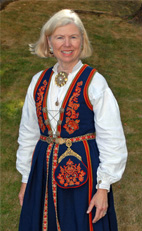
Vest Telemark bunad with blouse
bound together with Sølje;
buttons with chains binding
top vest, waist clasps &
purse clasp/hook.
Wearing a bunad, a festival costume, has many connotations and denotations and is an important event of many levels. In many places and many circles a bunad is wonderful for any and all special occasions.
One primary focus is appreciation of and homage to your Norwegian heritage in general and to your part of Norway in particular. It is customary to wear a bunad or folkedrakt from an area to which you have a genetic or residential connection. Then you won't have to explain to those who greet you (feeling they've found someone from their region) that you just liked that particular dress.
Your bunad should display good to excellent fabrics and workmanship, fit nicely, and be clean and in good repair. Because you are wearing traditional (or traditionally related) clothing, conservative makeup and hairstyles are suitable. More contemporary additions such as earrings, high heels and nylons are out of place. References to the bunad police are made partly in jest!
Since a bunad is a festival garment, less ornate traditional dress is more suitable and practical for work situations. Everyday cotton or wool costumes, colored and patterned shirts and aprons, and simpler sølje are among the possibilities. Consider getting an everyday (hverdags) dress, which is less expensive and easier to make and care for. If fabrics are carefully chosen and workmanship is excellent, you will have appropriate clothing for traditional events.
Acquiring & Care of Bunad
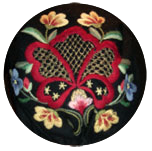
Embroidery on back of hat
from a Gudbrandsdal bunad
There are many avenues for acquisition of a bunad. Used bunader are sometimes available through inheritance, gift, or purchase. Traditional clothing is usually made for easy alteration.
Linen requires special care because of the absorbency of the fibers and should be laundered by hand after each use in tepid water with a neutral detergent. Chlorine bleach must not be used. Squeeze but don't rub. Rinse in fresh water at least five times since the shirt will yellow unless it is rinsed very thoroughly. Hang to drip dry or roll in a towel before hanging, but do not wring out. Store in a dark place in a fabric sack or towel. Just before the next use, dip fabric in cold water, dry overnight, and iron on cotton setting with a soft fabric underneath for embroidered sections. Steam irons have made it much quicker and easier.
Most bunader are acquired from Norway, either through local relatives or through the Bunad og Folkedrakt Nettverk. It is important to realize that a bunad can be assembled over time. The skirt and bodice may be worn with a plain shirt and simple sølje until further investments of time and/or money are made. Some festival costumes or portions of costumes can be made from patterns and fabrics available in the United States, while for others purchase in "kit" form or custom made from Norway is necessary.
Bunad Jewelry
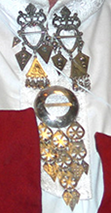 Silver was magical in Norway, of superstition and legend. The mines were thought to belong to the mountain trolls who were the very best silversmiths. Silver was used to protect against storms, heal sickness, consecrate water and more. A small silver brooch was pinned on a baby's clothing so the trolls couldn't make a swap with a troll baby. Silver pieces handed down from previous generations were especially valued because of their ancestral and spiritual connections.
Silver was magical in Norway, of superstition and legend. The mines were thought to belong to the mountain trolls who were the very best silversmiths. Silver was used to protect against storms, heal sickness, consecrate water and more. A small silver brooch was pinned on a baby's clothing so the trolls couldn't make a swap with a troll baby. Silver pieces handed down from previous generations were especially valued because of their ancestral and spiritual connections.
The above halsknapp (neck closure) and large sølje (brooch) on blouse gives clues to family's wealth and higher social ranking.
The silver jewelry worn by his wife and daughters was an important status symbol for a farmer, as well as a way to store the family wealth. Many farmers, especially in Setesdal and Telemark, became silver craftsmen to add to their incomes. Pieces could be stamped, cast or cut from sheet silver and embellished with engraving, filigree.
The word "filigree" means thread/wire — ball/grain in Latin and describes silver threads and balls of different sizes and dimensions, soldered and twisted together into a design. Filigree work probably came from the Far East which followed the old trade routes through the Middle East and Europe. It first came to Norway in Viking times and was again popular during the Renaissance. In the early 1700's filigree was a basis for the development of many regional folk jewelry designs in Norway.
Guilds of silversmiths date back to 1568 and only guild members could legally work with silver. Guilds provided education for silversmiths and were found only in large towns. Theoretically, the government controlled all precious metals and the guilds controlled who could work and where. However, silver work continued in the countryside.
Today machinemade silver is also available. These pieces are either stamped from thin sheets of silver or cast from a mold with handmade parts. They cost about one-third the price of handmade pieces and, as with handmade pieces, the quality varies widely. In deciding what to buy - and how much to spend - consider that you will wear a piece for the rest of your life and pass it on to children and grandchildren. It is traditional to collect pieces over a lifetime, rather than purchasing them all at once.
Jewelry Types & Care
Women's silver jewelry usually include: a neck pin or button which holds the shirt together at the neck, a brooch fastened across the front slit of the shirt (and almost never fastened to the bunad itself!), cufflinks and shoe buckles. Rings, belts and bridal accessories are common, but earrings are not traditional with folk costumes.
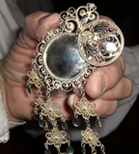
Fine example of the Norwegian's
cleverness at making a sølje practical
and beautiful at the same time.
This one's mirror surface is
proctected by a gorgeous
cover which is shown open!
The jewelry is quite regional in design, although the boundaries are often vague and inherited pieces are always appropriate. Simpler pieces should be worn with more everyday costumes and in all cases care must be taken not to wear more silver than is appropriate.
Many questions have been raised about the meaning of the elements in Norwegian folk jewelry. There are some symbols whose meanings are universal and ancient, and some elements that have different meanings in different places and times. Basically a silver pin is used to hold the shirt closed. The circle is a universal shape and the prong across the middle is to secure the pin. The rich layers on many pieces are quite intriguing, and the hanging parts glitter and/or tinkle to call attention to the piece.
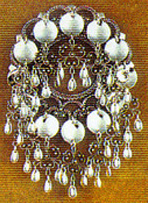
Example of sølje (brooch)
which has a mirror surface
Special care is needed to preserve silver. DO NOT use dip solutions since they destroy the silver. Old silver is supposed to look old; it's called patina. Silver should be washed since the crevices accumulate dirt, and soap and water will do for this. Dampened baking soda, or a mixture of natural soap with a bit of ammonia, used on a soft, worn toothbrush also works well. A silver cloth can be used to rub the leaves and other flat surfaces.
Keep silver in separate boxes so chains and pins don't destroy the delicate work. Do not use rubber bands near your silver as they contain sulphur which can permeate the box and affect the silver contents.
Pieces with a prong in the center and no pin on the back should probably not be altered. If they are that old, they may have antique value. The shirt fabric is pulled through the pin's center and the prong goes through the fabric to secure the pin.